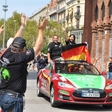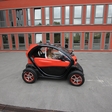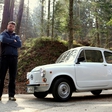
The IT entrepreneur aimed to do what Verne had set Fogg to, but his only means of transport would be an electric car. Instead of 80 days, it took him 127 to cross the finish line. Nevertheless, he didn't give up hope. Not only will he try again next year, but he was also inspired to organize a race. The second El Duro, as the Spaniard named it (for more information visit www.80edays.com), will begin next year on June 16, with the objective of traveling the world in 80 days. With more tha a dozen international teams currently signed up, and more to come, all credit for the event goes to Rafael, his endurance and his love for electric cars.
What prompted you to travel around the world on electric wheels?
Someone once said that it was not possible. Impossible is not something I believe in. I owned an electric car, and that spurred me to the point where I was willing to give it a go. Unlike Phileas Fogg, you were traveling westward, and failed to gain an extra day, thanks to the time zones. That's right, I was going westwards, from Barcelona to Germany, then across the Atlantic into the US, then across the Pacific and so on. I actually lost one day.

You set out with a Tesla Roadster, but back then the Tesla Supercharger network of charging stations was not yet avaialable.
No, not at all. They would have made our journey much easier and faster.
So where did you end up charging your car?
I embarked on the journey with a very simple premise: if I see a lit house, there must be electricity. And if there's electricity, then that's where I can charge my car. Very simple. There are billions of electrical sockets in the world, far surpassing the number of gas stations, but it never occurred to me that electricity is also found at every gas station. There's not much you can do without electricity, and gassing up is no exception.
So, finding plug sockets was never an issue?
Even in the most remote areas, they were more than easy to come by. I thought I was going to have to, more often than not, charge the car with low, barely acceptable voltage, but that turned out not to be the case. When you travel, you normally sleep in hotels, like I did. A hotel comes with a powerful enough electric socket, even in developing countries. 30 or 32 amp sockets (which is twice the power of classic domestic sockets) are almost everywhere, and three-phase sockets were not a problem, aside from the US. In Europe, Russia and Asia, I used the same plug.

No charging stations, then?
There was enough infrastructure that almost no charging stations were necessary. Charging EVs brings to mind charging stations, which have become a lucrative business. But in reality, the already-existing infrastructure is perfectly sufficient, and has been for a long time, only we aren't aware of it. I am no exception. I would have gone on a trip like that much earlier, if I'd known.
How much time did you spend on planning?
Zero, really. When I heard that a French team wanted to set the record of traveling around the world with a production electric vehicle, which was also my idea, I had to snap into action. I wanted to be the first, just to demonstrate that you don't have to have an expertise in electricty, or electric vehicles. As an IT specialist, I know very little about electrictiy, and I take no special interest in the technology of electric vehicles. My intention was to show that you can circumnavigate the world by going electric. They said it was impossible, but they only spurred me on. Great, I though to myself, I can prove them wrong now.
Was this your first electric car?
Yes, my very first. But I'd used it on a daily basis for about a year before setting out.
No planning ahead, you say?
Well, from one hotel, restaurant, gas station to the next, yes. Everywhere I went, I was able to charge my car via three-phase sockets, which resulted in much faster charging than what I'd imagined beforehand. I wasted my time on things I hadn't anticipated, simply because I never prepared. Borders, for instance, visas and things like that.
Was China problematic?
A little. It's considered very supportive of electric mobility, still I was not allowed to drive. I was told by the policemen that I didn't have the persmission to navigate their roads with my car. I asked to speak with their superiors at many levels, and ended up spending three weeks just to get enough attention in the political arena to get things moving. I met a person who was politically very supportive of electric mobility, and really loved the project. "Why didn't you have a word with me earlier?" he asked. I then received a pile of signed documents embellisehd with stamps, there must have been around 50. That solved all my problems. Still, I lost three weeks.

How would you describe a typical day on your journey?
Bureaucratic hurdles and transoceanic segments aside, my days were more or less the same. Morning driving was followed by lunch and charging, then I drove some more in the afternoon, until I settled in at a hotel for the night, where I also charged my car. Not very exciting. The car had a driving range of around 360 kilometers, but I thought it was better to be a bit conservative, so each morning and afternoon I covered from 250 to 300 kilometers, with charging breaks in between. I averaged around 500 kilometers a day.
In the four-month period on the road, did you ever lose interest?
No, because my mind was always one step, one leg, ahead of me. There was always something that distracted me. In Kazakhstan, for example, my biggest issue were the roads and too few maps, not charging. I often felt like Columbus, I was even forced to rely on the sun for better orientation, all because my GPS didn't work there. You get to a junction, there are no signs, nothing. You want to head in the directon of Astana, only you have no idea where Astana is. Luckily, the road network in Kazakhstan is much less dense than in Germany, for example, which means fewer intersections and less guessing.
It sounds like Kazakhstan was the biggest challenge, compared to other countries you traversed?
In terms of driving, absolutely. Their roads are in a very bad state, and with a ground clearance of only 12 centimeters, I often found myself in a pickle.
What about China?
The roads in China are excellent, comparable to Swiss roads. There are lots of highways. I often felt as though the roads had only just been paved, exclusively for me. Maybe I can "blame" it on the politician who arranged my entry into China. [laughter] I was in the middle of Gobi Desert, all by myself on a straight, beautiful asphalt road. Suddenly I hit a bridge that was under its final phase of construction, with a few hundred men at work--I don't know where they came from, or where they slept. There was nothing but desert, the road and a newly-finished bridge.
You won't be traveling alone, next time you try to conquer the world?
No, this time we are setting up a race around the world with a minimum of 10 teams, which means I won't have to wander the world alone anymore. Unlike the first time, when it was just you and your car, you'll also have a co-driver this time? Yes, co-drivers will be a must this time, namely for safety reasons. I'm familiar with the conditions now, the treacherous parts, so I know that co-drivers are a necessity. During my solo journey, I did things I'd never wish on anyone. I'd like to avoid them altogether if possible, now that many teams are in play.

The objective of the race is to get around the world in 80 days. Is that more of a realistic objective now?
Yes. The principle of day-to-day activity is basically the same, the only difference is that, with the availability of Superchargers and other high-performance charging stations for fast charging, we'll be able, in most parts at least, to exceed 500km a day. With the Tesla Model S, even two-fold. Also, with my hands-on experience with border control and bureaucracy, we should be able to lose no more than one week at border crossings, not three.
This time, will you participate with your old car, or your Tesla Model S?
I haven't made up my mind yet. The Roadster I used last time is expected to receive an upgrade, with an increase in its driving range. If that happens in timely fashion, I'd of course stick with it. Though I'm still in the dark with regard to three-phase charging via Superchargers, and so on. I'll decide once that's cleared up--three-phase charging is the only reasonable choice in some places. It looks like most teams are planning to drive a Tesla.
Why did you introduce the two-driver rule?
Let's say I was lucky that my car needed eight hours to recharge, which was enough for me to recharge my own batteries. Now, with charging times limited to one or two hours, we'd allow the drivers to go without sleep, which may have very dangerous consequences at such a pace. We also prohibited night-time driving in Kazakhstan and Russia, due to poor and dangerously unpredictable roads. But everyone wants to break my record.
While we're on the subject, it's lasted a good three years, in spite of advancements in the technology and charging infrastructure. Why is that?
I don't have an answer to that. I've improved my own record from 194 to 127 days, which is remarkable. These days, with Superchargers, it's possible to do it within 80 days.
Even with the advantage of Superchargers, some teams chose cars other than Teslas.
The upcoming project, the race, is not only bout setting a new record. I would also like to demonstrate that pretty much every electric vehicle can be equal to such an adventure. The Renault Zoe, for example, is among many that will take part in the race. By the time it starts, the car will be fitted with a better battery, delivering a 300km driving range, which will put it up there with my Roadster. So 80 days are no longer impossbile.
And you will only allow production cars to participate?
Yes, of course. Fine-tuned cars can join us, but not as competitors. The competition is reserved only for production electric vehicles. Fine-tuned cars usually come with a much better range, which wouldn't make it fair play. Besides, our goal is to prove that a widely-accessible production electric vehicle can be up to the task. Driving range is not at all the main issue, even compared to regular cars. The other day, I stopped at a gas station that happened to feature a charging station. As I plugged in my car, I threw my eye on the classical engines, one of which had just pulled in. To gas up, he had to first wait for his turn in a queue, then he went in to pay and again, as usual, hit a queue. When he drove off, I walked to my car that had, in the meantime, charged for a good 250 kilometers. Sure, there's a difference, but one that's barely noticeable in everyday life. Long driving range is what car manufactueres tend to publicize in regular engines.

A thousand and more kilometers, but who gets over one thousand kilometers in one go?
Who doesn't take at least one or two breaks, to stretch their legs a bit, to use a restroom? Driving range is just a theoretical number, but it is only a matter of time before the EVs climb to the 500 km mark, in terms of their driving range.
What about battery development?
That brings to mind computer processors. They said repeatedly they could never go any faster, which turned out to be nonsense. Technology has improved dramatically, and progress has never come faster. Today, laptops, even the cheapest ones, will work on a single battery charge, for hours and hours whereas, in the past, one hour seemed a lot, even for the best. Progress knows no limits, and to stop where we are today would be just another word for regression.
What, in your opinion, will be the milestone that will mark the end for the internal-combustion engine?
I propose this: a car with 1000 km driving range, that can recharge in only a few minutes, and costs 20,000 Euros.
Profesionally, you're a IT specialist. Many of those who were the first to buy electric cars are from IT.
Yes, the situation is similar with the race participants. Obviously, we're more open to new technologies. Once technology is half a year old, we already start to think that it's outdated, and try to come up with newer, better solutions. We're used to rapid shifts in technology, and we embrace them faster, I think.



